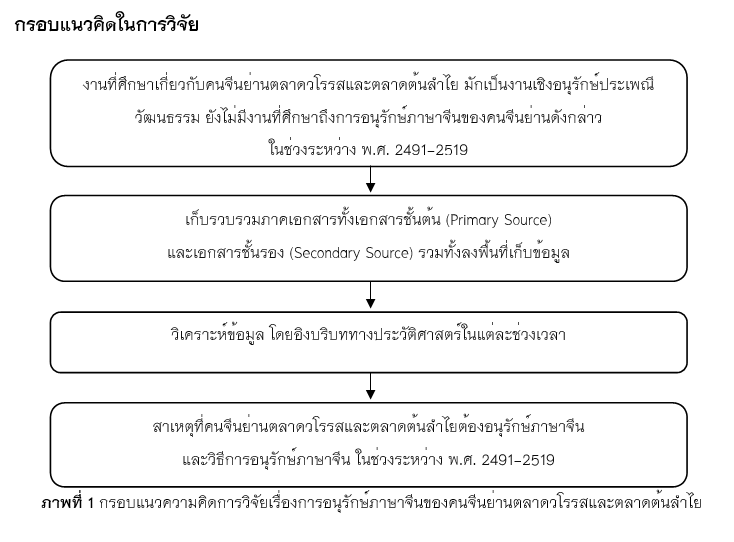The Conservation of the Chinese Language of Chinese People at Waroros Market and Ton Lam Yai Market During 1948 to 1976
Main Article Content
Abstract
This research aimed to investigate the preservation of the Chinese language among the Chinese community in the Waroros and Ton Lam Yai markets during the period 1948-1976 A.D. This era was marked by a negative perception of Chinese identity by the Thai government and various international communities. The research sample consisted of 20 Chinese participants born before 1967 A.D. who have currently resided in the Waroros and Ton Lam Yai markets in Chiang Mai province. The sample selection was conducted through purposive sampling. In-depth interviews were employed as the primary data collection method, supported by a structured interview questionnaire. The data were analyzed by content analysis, linking the findings to the political context of both Thailand and China. The study revealed that the Chinese living in the Waroros and Ton Lam Yai markets were motivated to preserve the Chinese language during the period 1948-1976 A.D due to its essential role in various aspects of life. This included facilitating trade interactions among the Chinese community, communication within the family, the sustainability of Chinese culture and traditions, and maintaining relationships with relatives in China. Various methods were implemented to preserve the Chinese language during this period, such as sending children to Chinese schools, hiring teachers for home-based Chinese language instruction, regularly conversing in Chinese within the family, and sending children to study in China.
Downloads
Article Details

This work is licensed under a Creative Commons Attribution-NonCommercial-NoDerivatives 4.0 International License.
The articles published are copyrighted by the Graduate School, Chiang Mai Rajabhat University.
The opinions expressed in each article of this academic journal are solely those of the individual authors and do not reflect the views of Chiang Mai Rajabhat University or its faculty members. The responsibility for the content of each article rests entirely with the respective authors. In the event of any errors, the authors alone are responsible for their own articles.
References
Apavatcharut, S. & Charoenmuang, A. D. (2009). The story of Chao Kad 6th: Social, business and political of Chao Kad. Chiang Mai: Sangslip Printing. [In Thai]
Apavatcharut, S., & Charoenmuang, A. D. (2006). The story of Chao Kad 3rd: Social, business and political of Chao Kad. Chiang Mai: Sangslip Printing. [In Thai]
Chananon, P. (1987). On history and development of capitalistic economy of northern Thailand, 1921-1980. Bangkok: Social Research Institute, Chulalongkorn University. [In Thai]
Chokmukda, W. (2012). 150 years of Chinese history in the period of "sickness" from the opium war to world powers. Bangkok: Gypzy Publishing. [In Thai]
Chongfah Xinsheng Wanishbamring School. (2023). History of Chongfah Xinsheng Wanishbamrung School. Retrieved from https://www.chongfah.ac.th/?p=page-detail&page_id=1 [In Thai]
Dabphet, S. (2017). Social change and impacts on Chinese society since the cultural revolution. Department of History, Faculty of Social Sciences, Srinakharinwirot University. [In Thai]
Eaksittipong, S. (2010). The life of Chinese commoners in Bangkok during 1957 - 1974. (Master of Arts (History), Chiangmai University). [In Thai]
Goodenough, W. H. (1957). Cultural anthropology and linguistics. in Garvin P. L. (ed.), Report of the Seventh Annual Round Table Meeting on Linguistics and Language Study. Washington, D. C.: Georgetown University Press.
Herskovits, M. J. (1955). Cultural anthropology. New York: Knopf. [In English]
Ingkasit, R. (2019). Modern China. Sarakadee Magazine, 35(413), 32-95. [In Thai]
Klomsing, J. (2003). Identity preservation of Ethnic Chinese Thai in Chiang Mai City area. (Master of Education, Nonformal Education, Chiang Mai University). [In Thai]
Krueaphat, K., Laeheem, K., & Dhammasaccakarn, W. (2021). An analysis of Chinese cultural identity conservation in Thailand through social institutions. Journal of Language and Culture, 40(2), 96-111. [In Thai]
Leosiripong, P. (2018). Chinese music in Chiang Mai: the past, the changes and conservation and transmission in the present society. Department of Cultural Promotion, Ministry of Culture. [In Thai]
Li, C. (1988). Biography of confucius. Bangkok: Sukkhapabjai Group. [In Thai]
Nernhard, A. (2003). Sangkhom muang Chiang Mai 3rd generation. Chiang Mai: Nopburee Press. [In Thai]
Nernhard, A. (2013). Yan Kadluang (sangkhom muang Chiang Mai 39). Chiang Mai: Nopburee Press. [In Thai]
Ong, T. (2021). Language maintenance in Malaysia: A case study of the Chinese community in Penang. The International Journal of Speech, Language and the Law, 28(2), 273–279. [In English]
Ongsakul, S. (2010). History of Lanna. Bangkok: Amarinbooks. [In Thai]
Phetrung, M. (2010). The role of Chinese race in Muang District, Chiang Mai Province During Bangkok Period. (Master of Arts, Department of Archaeology, Graduation School, Silpakorn University). [In Thai]
Pimthong, N. (2016). Background of Chinese newspaper in Thailand. Retrieved from https://lek-prapai.org/home/view.php?id=76 [In Thai]
Pung Tao Kong Shrine Chiang Mai. (2006). Chiang Mai: Pu-Pae Printing. [In Thai]
Ronnakhanthosakul, K. & Damrongsakul, W. (2020). “Ting–Krajad” Chinese festivals: The spatiotemporal representation of Chinese–Thai identity in Lao Zhou alley, Chiang Mai province. Journal of Language and Culture, 39(2), 46-64. [In Thai]
Santayot, C. (2008). The construction of ‘Phrarajjaya Chao Dararasmi’. Bangkok: Matichobook. [In Thai]
Sattayanurak, A. (1991). Social changes, culture, and political developments in northern Thailand after World War 2. (Department of History, Faculty of Humannities, Chiang Mai University). [In Thai]
Skinner, G. W. (1957). Chinese society in Thailand: An analytical history. Cornell University Press. [In Thai]
Songprasert, P. (1976). The Thai government's policies towards the Chinese in Thailand (A.D. 1932-1957). (Master of Arts, Department of History, Graduate School, Chulalongkorn University). [In Thai]
Suksaranchit, S. (2015). 100 years of Chinese people in Phayao: Political and social dynamics. Journal of Social Science, Naresuan University, 11(2), 99-135. [In Thai]
Suwanchinda, P. (2017). The cultural adaptation of Chinese – Thai: Case study of Chinese – Thai at Chinatown area. (Master of Arts, Social Development Administration). [In Thai]
Tan, Q. (2020). The cultural identity of Chinese-Thai in Warorot market area, Chiang Mai, from 2012 - 2020. (Master of Arts (Cultural Studies), Graduation School, Chiang Mai University). [In Thai]
Tanmahapran, C. (2011). Yee Kor Hong. Bangkok: Book Panich. [In Thai]
Zhou, J. (2006). History of China. Bangkok: Nanmeebooks. [In Thai]


